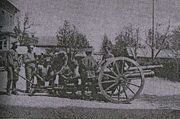
Sich Riflemen
Encyclopedia

Ukrainian People's Republic
The Ukrainian People's Republic or Ukrainian National Republic was a republic that was declared in part of the territory of modern Ukraine after the Russian Revolution, eventually headed by Symon Petliura.-Revolutionary Wave:...
. The unit operated from 1917 to 1919 and was formed from Ukrainian soldiers of the Austro-Hungarian army, local population and former commanders of the Ukrainian Sich Riflemen in Austria-Hungary
Austria-Hungary
Austria-Hungary , more formally known as the Kingdoms and Lands Represented in the Imperial Council and the Lands of the Holy Hungarian Crown of Saint Stephen, was a constitutional monarchic union between the crowns of the Austrian Empire and the Kingdom of Hungary in...
. The first kurin
Kurin
Kurin is a military term that was established by the cossacks.During the Second World War, the basic combat unit of the Ukrainian Insurgent Army was a kurin...
was formed in Kiev on 13 November 1917. Commanded by Col. Yevhen Konovalets
Yevhen Konovalets
Yevhen Konovalets was a military commander of the UNR army and political leader of the Ukrainian nationalist movement...
, the Sich Rifles had up to 25,000 men at their peak, including artillery, cavalry, reconnaissance and machine gun units.
The Sich Riflemen defended the government of UNR against the Bolshevik insurrection in the capital and later against regular Red Army
Red Army
The Workers' and Peasants' Red Army started out as the Soviet Union's revolutionary communist combat groups during the Russian Civil War of 1918-1922. It grew into the national army of the Soviet Union. By the 1930s the Red Army was among the largest armies in history.The "Red Army" name refers to...
forces that advanced into Ukraine in 1918. When Kiev was recaptured in March 1918 the Ukrainian Sich Riflemen guarded government buildings in the capital and maintained order in the city. The unit later expanded to include two infantry detachments, a cavalry unit and an artillery battery. With the establishment of Hetmanate
Hetmanate
The Ukrainian State or The Hetmanate was a short-lived polity in Ukraine, installed by Ukrainian Cossacks and military organizations under the support of the Central Powers, after disbanding the Central Rada of the Ukrainian National Republic on 28 April 1918.-History:On April 29, 1918 the head...
of Pavlo Skoropadsky
Pavlo Skoropadsky
Pavlo Petrovych Skoropadskyi 3 May 1873, Wiesbaden, Germany – 26 April 1945, Metten monastery clinic, Bavaria, Germany) was a Ukrainian politician, earlier an aristocrat and decorated Imperial Russian Army general...
the Sich Riflemen refused to serve him and were disarmed by the German forces that supported the hetman.
Soldiers from the unit joined other forces, notably Second Zaporozhian Regiment of Petro Bolbochan and attempted to reestablish the unit under the new command. In August 1918 Skoropadsky finally allowed a partial reestablishment of the unit in Bila Tserkva
Bila Tserkva
Bila Tserkva is a city located on the Ros' River in the Kiev Oblast in central Ukraine, approximately south of the capital, Kiev. Population 203,300 Area 34 km².-Administrative status:...
. The new unit consisted of 1200 men and was divided into an infantry regiment, an artillery battery and a technical unit. In Bila Tserkva, the Sich Riflemen led the revolt against hetman Skoropadsky and the ranks of the unit increased by November 1918 to 11,000. Later the two other Dnieper and Black Sea divisions joined the unit. In November 1918 with new recruits the ranks of the Riflemen swelled to 25,000. It played a crucial role in the establishment of the Directorate
Directorate of Ukraine
The Directorate, or Directory was a provisional revolutionary state committee of the Ukrainian National Republic, formed in 1918 by the Ukrainian National Union in rebellion against Skoropadsky's regime....
under Symon Petlura
Symon Petlura
Symon Vasylyovych Petliura was a publicist, writer, journalist, Ukrainian politician, statesman, and national leader who led Ukraine's struggle for independence following the Russian Revolution of 1917....
. In December the unit captured Kiev and was subsequently divided into smaller units.
Different detachments of the unit fought against advancing Bolshevik armies in Ukraine. Together with the Directory the Sich Riflemen fled from Kiev when it was recaptured by the Bolsheviks. The Riflemen also fought on different fronts against the White Russian
White movement
The White movement and its military arm the White Army - known as the White Guard or the Whites - was a loose confederation of Anti-Communist forces.The movement comprised one of the politico-military Russian forces who fought...
forces of General Denikin. In 1919 the unit took heavy losses in combat and later from typhus
Typhus
Epidemic typhus is a form of typhus so named because the disease often causes epidemics following wars and natural disasters...
. On 6 December 1919 the unit was finally demobilized. Some former soldiers were interned by the Polish army, others continued to fight in other smaller detachments in Ukraine.
Literature
- Orest SubtelnyOrest SubtelnyOrest Subtelny is a Canadian historian. Born in Kraków, Poland, he received his Ph.D. from Harvard University in 1973. Since 1982 he has been a professor in the departments of History and Political Science, York University, Toronto, Canada.-Career:...
. Ukraine. A history. University of Toronto press. 1994. ISBN 0-8020-0591-0. - Paul Robert Magocsi. The Roots of Ukrainian Nationalism: Galicia As Ukraine's Piedmont. University of Toronto Press. 2002. ISBN 0521819881.

